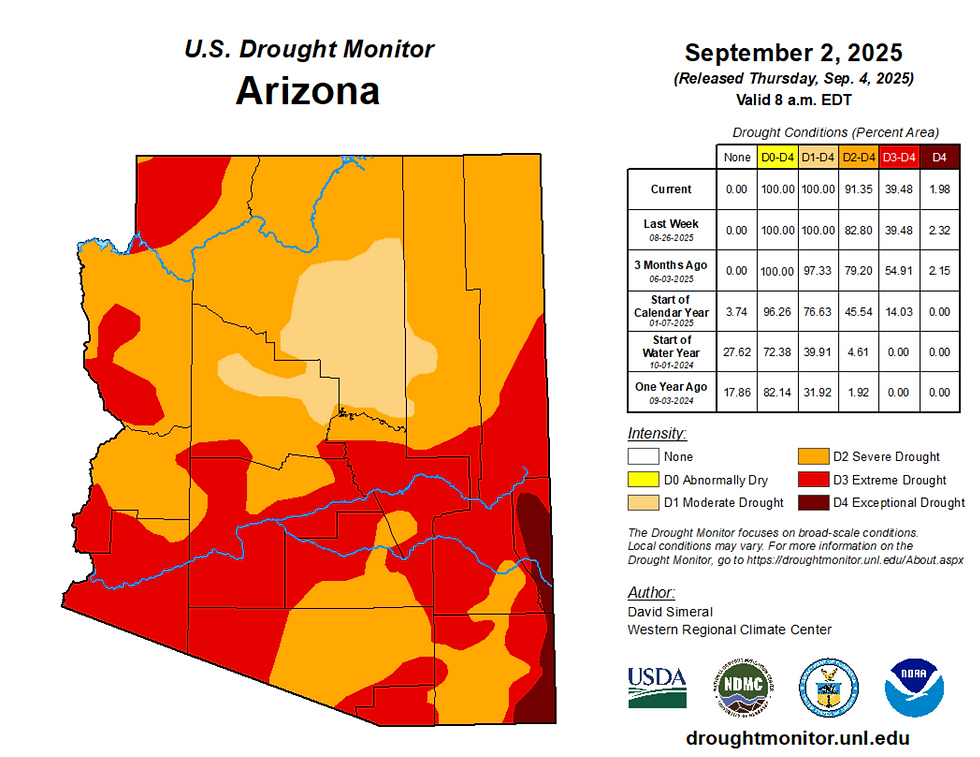Water Woes XL-H2O Update, Flood Frequency & Ag to Urban Water Transfer
- Mark L. Johnson

- Sep 10
- 3 min read
The end of the monsoon season (9/30/25) is upon us. Time for an H2O update, discussion on flood frequency and report on SB 1611-Ag to Urban Water Transfer.
Monsoon Update (As of 9/7/25)

Latest (9/7/25) Haywood Plot above shows very dismal 2025 monsoon precipitation with only 23 days to go. Monsoon precipitation through 9/7/25 is only 2.00 inches compared to total normal monsoon precipiation of 5.69". 2025 monsoon precipatation is tracking to be within the driest 5 years on record.
Arizona Remains Orange & Red!

91% of Arizona is in Severe Drought and 40% is in Extreme Drought
Colorado River System Status

Colorado River System main reservoir capacities remain alarmingly low and actually lost 3.43 million acre-feet (MAF) over same period last year.

Snow Water Equivalent (inches) in the upper Colorado River Watershed is 57% of normal.
The United States Bureau of Reclamation (USBR) is still projecting the Colorado System will be in Tier 1 Shortage for 2026.

Flood Frequency

Typically stormwater facilities are designed to handle the 100-year precipitation frequency recurrence interval (100-year flood). The National Oceanic Atmospheric Administration (NOAA) prepares precipation frequency charts (NOAA Atlas 14) for various areas throughout the US. The NOAA Atlas 14 chart for Dove Mountain is shown above.
On 8/19/25, a monsoon storm barreled through Dove Mountain. I recorded 1.2 inches of rain in 30-minutes. Seems like a lot of precipation but using the NOAA Atlas 14 chart (red boxes), this rainfall event is only classified with a return frequency of 10-years, which means this precipitation event will occur every 10-years (on average). The high winds during that storm did more damage than the rain.
To get to the 100-year return frequency (purple boxes) there would need be 1.9" of rain in 30 minutes.
There has been a 100-year return frequency event in our area. In 1983, Tropical Storm Octave caused widespread flooding in the Guild Wash/Tortolita Fan watershed and along the Santa Cruz River. From September 27 to October 3, 1983, there was as much as 11 inches of precipitation, resulting in damaging floods. There were 8 lives lost and $226.5 million in damage. US Geological Survey-Floods of October 1983 In Southeastern Arizona Report calculated the flood return frequency of that event for the Santa Cruz River in Tucson and Marana to be greater than the 100-year flood (1% chance).
The moral of this story---we have not seen the big one in sometime and the Town of Marana and all Subdivision HOA's need make sure their respective stormwater facilties are structurally sound and free of debris, vegetation and accumulated sediment.
SB 1611-Ag to Urban (A2U) Water Transfer
On 6/30/25, Governor Hobbs signed SB 1611 which allows the transfer of grandfathered agricultural groundwater irrigation rights to developers and/or water agencies at a reduced withdrawal rate. The theory behind the legislation is that farm water use is about 4 acre-feet/acre and urban water use is about 1 acre-feet/acre. Thus, saving about 3 acre-feet/acre. Here is how the legislation appears to work:
Groundwater Act of 1980 grandfathered certain agricultural groundwater irrigation rights
Grandfathered agricultural groundwater irrigation rights can now be permanenlty relinguished in exchange for a physical availability credit with the following conversion provisions:
Phoenix & Tucson Active Management Areas
2.0 acre-feet/acre and 67% of the groundwater use must be replenished, or
1.5 acre-feet/acre and 50% of the grounwater use must be replenished, or
1.0 acre-feet/acre and 33% of the groundwater use must be replenished
Pinal Active Management Area
1.5 acre-feet/acre and 100% of the groundwater use must be replenished, or
1.0 acre-feet/acre and 67% of the groundwater use must be replenished, or
0.5 acre-feet/acre and 33% of the groundwdater use must be replenished
Groundwater must be used within the retired agriculture irrigation acres or within 1 mile of the boundary of the retired agriculture irrigation acres.
Several other adminstrative requirements
This legislation will allow development to occur in areas that were under moratorium.
The good news is replenishment is required whereas it was not required by the agricultural irrigation right. However, there are limited new sources of water supply for replenishment purposes.
Arizonans needs to keep a watchful eye on the Central Arizona Groundwater Replenishment District (CAGRD) to ensure long-term, permanent replenishment water sources actually exist in the areas where the groundwater is being extracted. [See Water Woes XXXIII-CAGRD]
